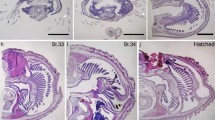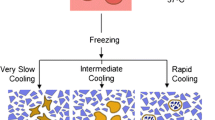Summary
The evaluation of the intracellular signal train and its regulatory function in controlling transepithelial transport with electrophysiological methods often requires intracellular measurements with microelectrodes. However, multiple impalements in epithelial cells are hampered by the small size of the cells. In an attempt to avoid these problems we fused cells of an established cell line, Madin Darby canine kidney cells, originally derived from dog kidney, to “giant” cells by applying a modified polyethylene glycol method. During trypsin-induced detachment from the ground of the petri dish, individual cells grown in a monolayer incorporate volume and mainly lose basolateral plasma membrane by extrusion. By isovolumetric cell-to-cell fusion, spherical “giant” cells are formed within 2 hr. During this process a major part of the individual cell plasma membranes is internalized. Over three weeks following cell plasma membrane fusion degradation of single cell nuclei and cell nuclear fusion occurs. We conclude that this experimental approach opens the possibility to investigate ion transport of epithelia in culture by somatic cell genetic techniques.
Similar content being viewed by others
References
Ainsworth, S.K., Karnovsky, M.J. 1972. An ultrastructural staining method for enhancing the size and electron opacity of ferritin in thin sections.J. Histochem. Cytochem. 20:225–228
Berridge, M.J., Irvine, R.F. 1984. Inositol trisphosphate, a novel second messenger in cellular signal transduction.Nature (London) 312:315–321
Bouachour, G., Planelles, G., Anagnostopoulos, T. 1988. Fusion of amphibian proximal convoluted cells into giant cells.Pfluegers Arch. 411:220–222
Boulpaep, E.L. 1976. Electrical phenomena in the nephron.Kidney Int. 9:88–102
Cereijido, M., Ehrenfeld, J., Fernandez-Castelo, S., Meza, I. 1981. Fluxes, junctions, and blisters in cultured monolayers of epithelioid cells (MDCK).Ann N.Y. Acad. Sci. 372:422–441
Dietl, P., Wang, W., Oberleithner, H. 1987. Fused cells of frog proximal tubule: I. Basic membrane properties.J. Membrane Biol. 100:43–51
Frömter, E. 1984. Viewing the kidney through microelectrodes.Am. J. Physiol. 247:F695-F705
Giebisch, G. 1987. Transport of electrolytes across renal tubules.In: Renal Physiology: People and Ideas. C.W. Gottschalk, R.W. Berliner and G.H. Giebisch, editors. pp. 165–216. American Physiological Society, Bethesda, MD
Graham, R.C., Karnovsky, M.J. 1966. The early stage of absorption of injected horseradish peroxidase in the proximal tubules of mouse kidney: Ultrastructural cytochemistry by a new technique.J. Histochem. Cytochem. 14:291–302
Handler, J.S., Perkins, F.M., Johnson, J.P. 1980. Studies of renal cell function using cell culture techniques.Am. J. Physiol. 238:F1-F9
Hannun, Y.A., Bell, R.M. 1988. Aminoacridines, potent inhibitors of protein kinase C.J. Biochem. Chem. 263:5124–5131
Harris, H., Watkins, J.F. 1965. Hybrid cells derived from mouse and man: Artificial heterokaryons of mammalian cells from different species.Nature (London) 205:640–646
Holthöfer, H., Virtanen, I., Pettersson, E., Törnroth, T., Alfthan, O., Linder, E., Miettinen, A. 1981. Lectins as fluorescence microscopic markers for saccharides in the human kidney.Lab. Invest. 45:391–399
Karst, W., Merker, H.J. 1988. The differentiation behaviour of MDCK cells grown on matrix components and in collagen gels.Cell Differ. 22:211–224
Knutton, S. 1979. Studies of membrane fusion: III. Fusion of erythrocytes with polyethylene glycol.J. Cell. Sci. 36:61–72
Köhler, G., Milstein, C. 1975. Continuous cultures of fused cells secreting antibody of predefined specificity.Nature (London) 256:495–497
Le Hir, M., Dubach, U.C. 1982. The cellular specificity of lectin binding in the kidney: II. A light microscopical study in the rabbit.Histochemistry 74:531–540
Madin, S.H., Darby, N.B., Jr. 1958. CCL-34,as cataloged in: American Type Culture collection Catalogue of Strains. H.O. Hatt, editor. 1975, Vol. 2, p. 47. Library of Congress, Rockville, Maryland
Markwell, M.A.K., Fredman, P., Svennerholm, L. 1984. Receptor ganglioside content of three hosts for sendai virus: MDBK, Hela and MDCK cells.Biochim. Biophys. Acta 775:7–16
Nelson, W.J., Veshnock, P.J. 1987. Modulation of fodrin (membrane skeleton) stability by cell-cell contact in Madin Darby canine kidney epithelial cells.J. Cell Biol. 104:1527–1537
Oberleithner, H., Kersting, U., Silbernagl, S., Steigner, W., Vogel, U. 1989. Fusion of cultured dog kidney (MDCK) cells: II. Relationship between cell pH and K+ conductance in response to aldosterone.J. Membrane Biol. 111:49–56
Oberleithner, H., Schmidt, B., Dietl, P. 1986. Fusion of renal epithelial cells: A model for studying cellular mechanisms of ion transport.Proc. Natl. Acad. Sci. USA 83:3547–3551
Oberleithner, H., Weigt, M., Westphale, H.J., Wang, W. 1987. Aldosterone activates Na+/H+ exchange and raises cytoplasmic pH in target cells of the amphibian kidney.Proc. Natl. Acad. Sci. USA 84:1464–1468
Paulmichl, M., Gstraunthaler, G., Lang, F. 1985. Electrical properties of Madin-Darby canine kidney cells. Effects of extracellular potassium and bicarbonate.Pfluegers Arch. 405:102–107
Rindler, M.J., Chuman, L.M., Shaffer, L., Saier, M.H., Jr. 1979. Retention of differentiated properties in an established dog kidney epithelial cell line (MDCK).J. Cell Biol. 81:635–648
Roos, D.S., Davidson, R.L., Choppin, P.W. 1987. Control of membrane fusion in polyethylene glycol-resistant cell mutants: Applications to fusion technology.In: Cell Fusion. A.E. Sowes, editor. pp. 123–144. Plenum, New York
Saier, M.H., Jr. 1981. Growth and differentiated properties of a kidney epithelial cell line (MDCK).Am. J. Physiol. 240:C106-C109
Seglen, P.O. 1973. Preparation of rat liver cells: II. Effects of ions and chelators on tissue dispersion.Exp. Cell Res. 76:25–30
Simmons, K. 1987. Membrane traffic in an epithelial cell line derived from the dog kidney.Kidney Int. 32:201–207
Simmons, N.L. 1984. Epithelial cell volume regulation in hypotonic fluids: Studies using a model tissue culture renal epithelial cell system.Q. J. Exp. Physiol. 69:83–95
Spring, K.R. 1985. The study of epithelial function by quantitative light microscopy.Pfluegers Arch. 405:S23-S27
Stewart, W.W. 1981. Lucifer dyes—highly fluorescent dyes for biological tracing.Nature (London) 292:17–21
Taub, M. 1985. Importance of homonally defined, serumfree medium for in vitro studies concerning epithelial transport.In: Tissue Culture of Epithelial Cells. M. Taub, editor, pp. 255–276. Plenum, New York
Wang, W., Wang, Y., Silbernagl, S., Oberleithner, H. 1988. Fused cells of frog proximal tubule: II. Voltage-dependent intracellular pH.J. Membrane Biol. 101:259–265
Westerwoudt, R.J. 1985. Improved fusion methods: IV. Technical aspects.J. Immunol. Methods 77:181–196
Willingham, M.C., Rutherford, A.V. 1984. The use of osmium-thiocarbohydrazide-osmium (OTO) and ferrocyanide-reduced osmium methods to enhance membrane contrast and preservation in cultured cells.J. Histochem. Cytochem. 32:455–460
Windhager, E.E. 1987. Micropuncture and microperfusion.In: Renal Physiology: People and Ideas. C.W. Gottschalk, R.W. Berliner, and G.H. Giebisch, editors. pp. 101–129. American Physiological Society, Bethesda, MD
Zimmermann, V., Vienken, J. 1982. Electric field-induced cell-to-cell fusion.J. Membrane Biol. 67:165–182
Author information
Authors and Affiliations
Rights and permissions
About this article
Cite this article
Kersting, U., Joha, H., Steigner, W. et al. Fusion of cultured dog kidney (MDCK) cells: I. Technique, fate of plasma membranes and of cell nuclei. J. Membrain Biol. 111, 37–48 (1989). https://doi.org/10.1007/BF01869207
Received:
Revised:
Issue Date:
DOI: https://doi.org/10.1007/BF01869207




